Yesterday Wild Turkeys saved the day for me along Promontory Road. There sure wasn’t much else out and about to photograph.
Wild Turkeys can be fairly common in certain mountainous areas of Utah but they’re often in agricultural areas near small towns and those types of habitats don’t much appeal to me as background. I photographed these birds in a truly natural setting and the turkeys themselves were skittish, wild and unaccustomed to the trappings of man. Humans are the major predators of adult Wild Turkeys so in the wild they’re extremely wary of us.
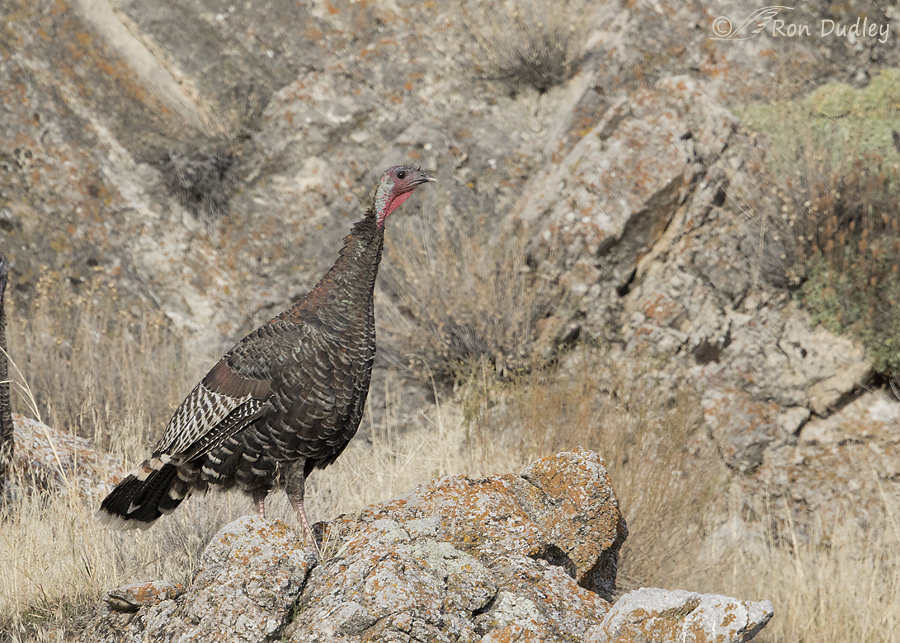
1/3200, f/6.3, ISO 800, Canon 7D Mark II, Canon EF 500mm f/4L IS II USM + EF 1.4 III Extender, not baited, set up or called in
This big male was the obvious leader of the pack. He was usually more out in the open than the rest of the flock and he was often calling to the other birds who would eventually come out of cover when he deemed it safe to do so. He was obviously quite wary of my pickup at first but soon…
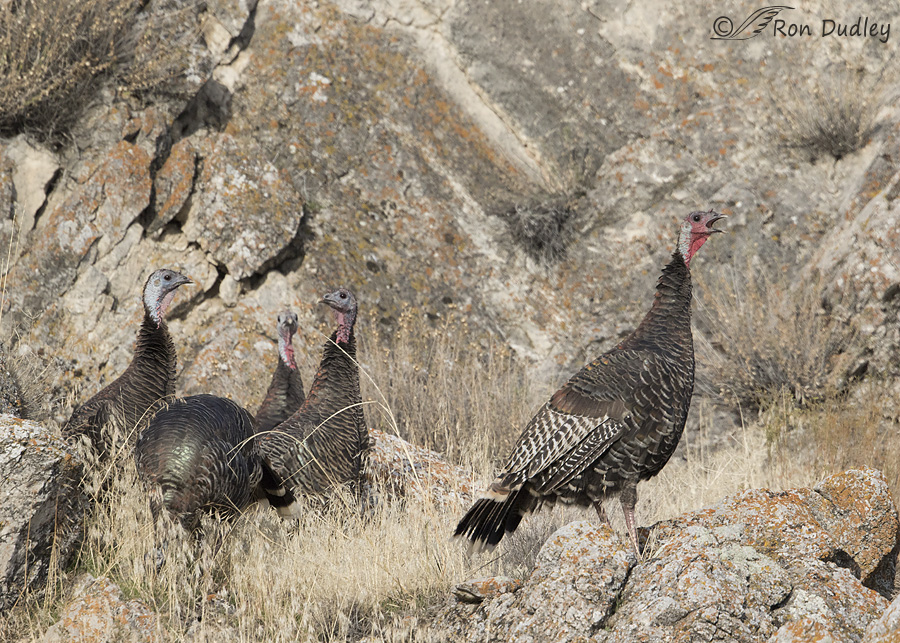
1/2500, f/7.1, ISO 800, Canon 7D Mark II, Canon EF 500mm f/4L IS II USM + EF 1.4 III Extender, not baited, set up or called in
some of the other turkeys came out in the open too, apparently as a result of him calling them.
It was difficult to discern how many turkeys there were on the side of the mountain. There was at least two fairly large groups of them separated from each other by some distance. I only got glimpses of birds in the other group but I could hear them calling as they moved about.
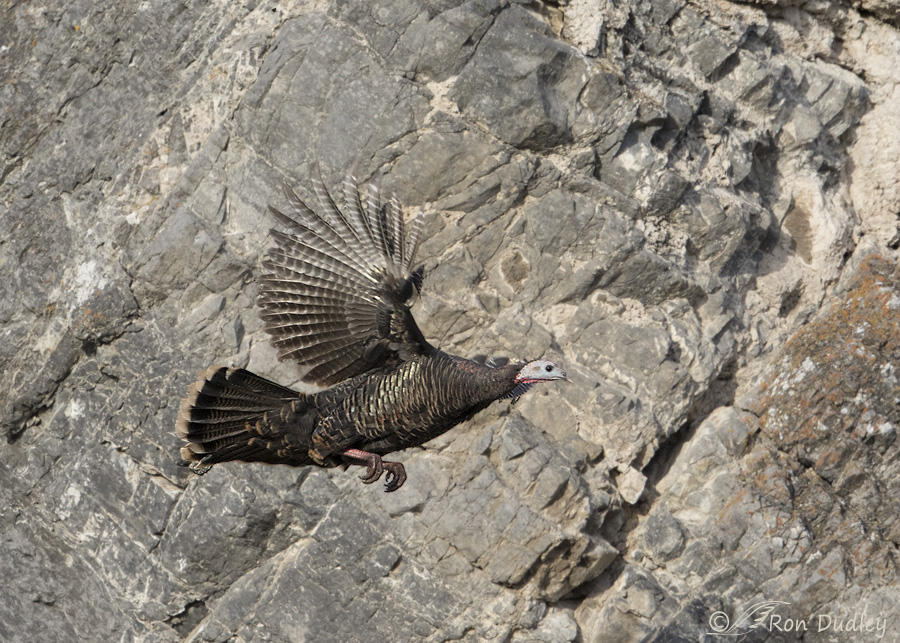
1/2000, f/6.3, ISO 800, Canon 7D Mark II, Canon EF 500mm f/4L IS II USM + EF 1.4 III Extender, not baited, set up or called in
I had multiple opportunities to photograph turkeys in flight as they flew from place to place on the side of the almost vertical mountain but none of them were very sharp.
Utah has three subspecies of Wild Turkeys but most of ours are either Merriam’s or Rio Grande. “Rios” can be distinguished from the other subspecies by the coloration of the tips of the tail feathers, coloration of the upper tail coverts, and the barring in the primary wing feathers. In the Rio Grande turkey those feathers are buff or tan, in contrast with the white tips of the Merriam’s subspecies. Those feathers were tan or buff in all of these birds I photographed so I believe them to be Rio Grande Wild Turkeys.
But, Wild Turkeys often hybridize so identifying them as to subspecies can be difficult. If I’m wrong please correct me (due to the softness of this image I only include it because of the good look at the tan colors at the tip of the tail which are definitely not white).
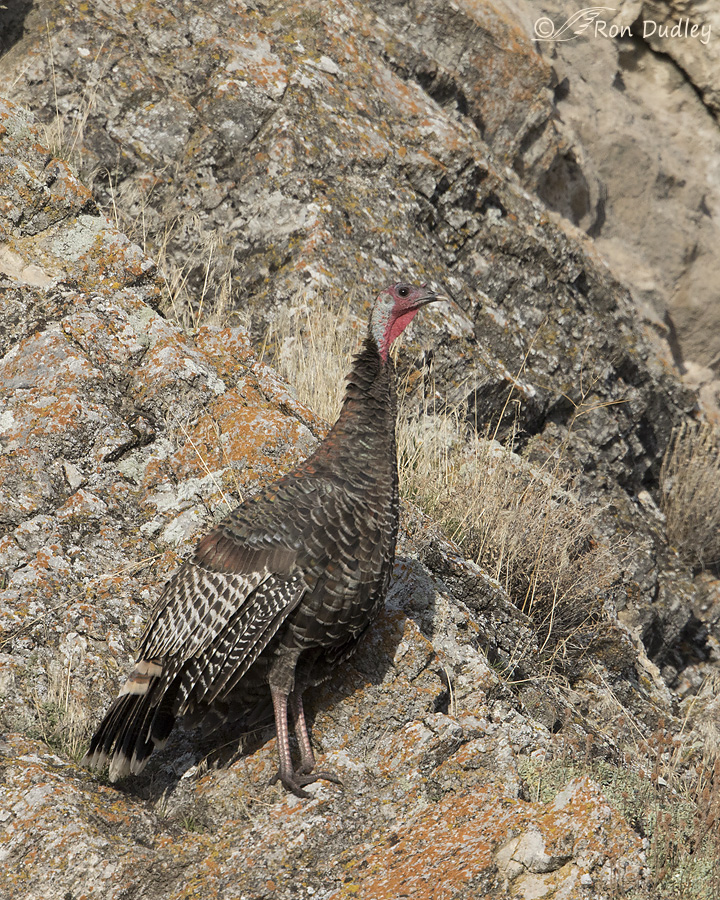
1/2500, f/7.1, ISO 640, Canon 7D Mark II, Canon EF 500mm f/4L IS II USM + EF 1.4 III Extender, not baited, set up or called in
Here the big tom was obviously contemplating flying to a higher spot on the side of the mountain (in the direction he’s looking) but after some time he turned around and led the rest of the flock in the opposite direction – down the very steep mountain.
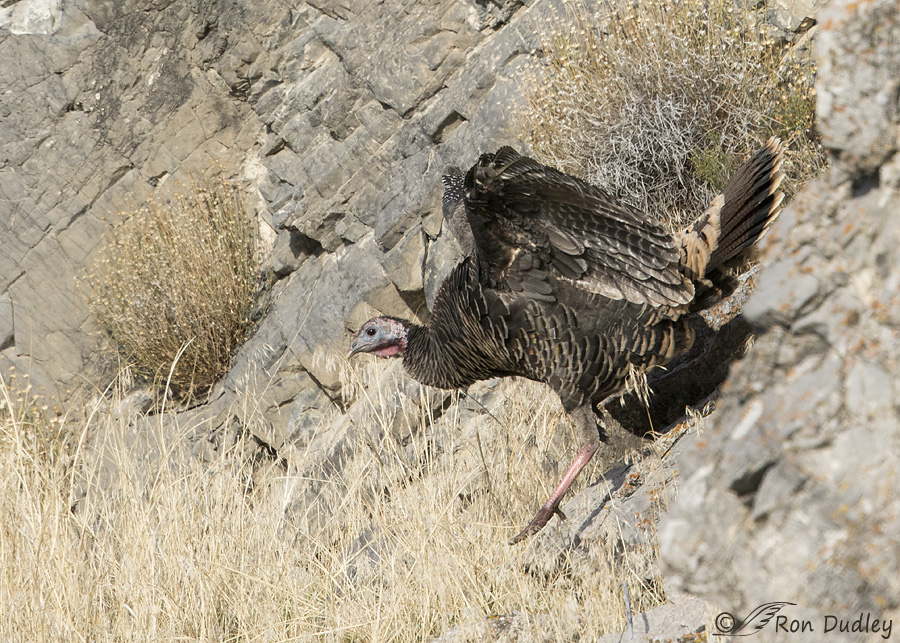
1/2500, f/7.1, ISO 640, Canon 7D Mark II, Canon EF 500mm f/4L IS II USM + EF 1.4 III Extender, not baited, set up or called in
It was so steep that they half flew, half ran down the mountain. Because of the tilted layers of the sedimentary rock in the background it almost looks like this image needs rotation to level it until we notice the angle of the turkey’s left leg and the vertical direction the vegetation is growing.
I don’t see or photograph Wild Turkeys very often so these birds were a treat for me. It was especially enjoyable to hear their calls bouncing off the mountain in my direction. I can hear them in my head as I type this post.
Ron


Super shots Ron I’ve seen Wild Turkeys every once in a while but I’ve never seen one fly. In fact we saw 4 just a while ago when returning home. I didn’t have my camera so we went home and back to their location. They were still there so we pulled over and put our flashers on. I didn’t want to get out of the car for feat they would head for cover. They quickly decided to cross the busy road. They did cross the busy road at a leisurely pace and the cars all stopped while they crossed safely, I suspect it was our flashers that attracted their attention.
Charlotte Norton
What a treat. For you and for us.
Of course they are wary. They would be ‘bird-brained’ not to be.
Thanks, EC.
My 117 lb. rescue, a mellow, yellow lab/golden retriever ( who hates water and refuses to retrieve anything) is a natural peacemaker. I’ve never heard him utter a single derogatory word, not even a growl. If you don’t like the other two candidates, you might want to vote for him. His name is “Bo”….short for “Bonus”…
Bo sounds like a great dog, Patty.
Bo wants, and tries, to be a lap dog…never gives up, likes to “hold hands”, has never groped or mocked anyone, likes everyone ( a liitle too much), regardless of nationality, ethnicity, color, religion,gender, age, or body shape, is never greedy (backs out of the way so other two can get their share of treats), pays his fair share of taxes, never stiffs those of us who work for him, is happy to release any and all tax information and never tells lies. He has big paws so probably has a big you-know-what, if that matters……:-)
I have a flock of wild turkeys who visit most every day. I put out some cracked corn for them & love to watch their antics. This year they have taken to landing on the roof of my car or sometimes on the balcony, looking in the window at us. Love them. Thanks for your pics.
I’m envious, Sarah. That would be so interesting and a lot of fun to see.
Very interesting shots and comments. These big birds are so much smarter than our domesticated fowl…also, often protective of fellow flock members. If one of my falconer friend, Jim’s, birds attacks a wild turkey, the other turkeys rush to the victim’s aid and his bird can get badly beaten….
Patty, I’m not surprised. I suspect there are very few raptors that would mess with an adult Wild Turkey.
The Turkey in flight looks even more awkward than a Duck – didn’t think that was possible. The only time I’ve ever seen wild Turkeys was in Virginia, in the vicinity of the Potomac River, many years ago, now. So it is a treat to see your photos. In the second shot I was counting bodies, and realized that what appeared to be a bird (far left) was actually a shadow and a plant. It is fun to see you post something different like this.
Susan, whenever I’ve seen them fly, which hasn’t been very often before this encounter, I marvel that such large birds can even get off the ground.
I hope all of you who love wild turkeys have read Joe Hutto’s remarkable book, “Illumination of the Flatwoods”. Some may have seen the video (“My Life as a Turkey”) about his having imprinted baby turkeys on him as they hatched. Then he literally joined them day and night from hatching until they ‘banned’ him from the flock as adults. He learned their language, marveling at their intelligence, discernment and social interchanges. Well, his book is even more remarkable. His writing is precise, poetic and deeply evocative, calling the best of Annie Dillard’s work to mind.
I just ordered a used copy…thanks for the tip…
I’ve seen the video, Alison. It was captivating.
I loved seeing the turkeys in the midst of that difficult and beautiful terrain–perfectly “cryptic” for them–they even appeared to have some of the orange lichen sprinkled on their backs !
I noticed how cryptic they are in that habitat too, Kris. I wonder how many times I’ve driven right past them and never even seen them.
I love wild turkeys and you have some really neat shots! I go to a place in the Santa Cruz mountains for meditation retreats and there are several social groups of wild turkeys that live on the property. I’ve seen the males in full display and have even seen some very young babies (which I referred to as gobblets when I was little, so that has stuck ), but I’ve never seen them in flight. This is a real treat!
), but I’ve never seen them in flight. This is a real treat!
Thanks very much, Marty.
Great shots, very appropriate this month!!
Vermont almost extirpated this species due to habitat loss and over hunting. I can remember I had to see my life bird in MI some years back. But, now they are quite plentiful in the state, but still very wary.
Thank you, Dick.
Turkeys weren’t reported in Utah by early trappers and settlers but their bones have been found at archeological sites in our state. I wonder why they originally disappeared – perhaps it was the drought that apparently extirpated many of the Puebloans.
Beautiful – I’ve never seen a wild turkey in flight! Glad they cooperated for you to get some shots of them. That is some rough terrain.
Glad they cooperated for you to get some shots of them. That is some rough terrain.
Judy, that terrain wasn’t only tough for the birds to negotiate it was tough for me to photograph them in. Because of the almost vertical mountainside the background was nearly always very close to them and as a result many of my images were soft.